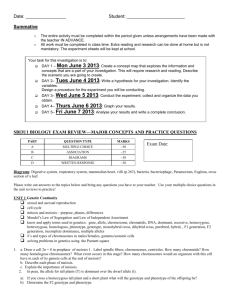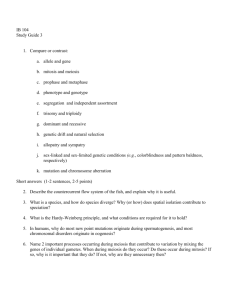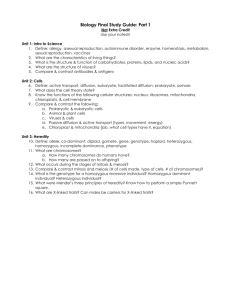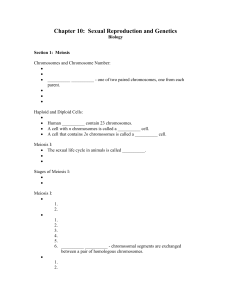S11 Answers #1 10th
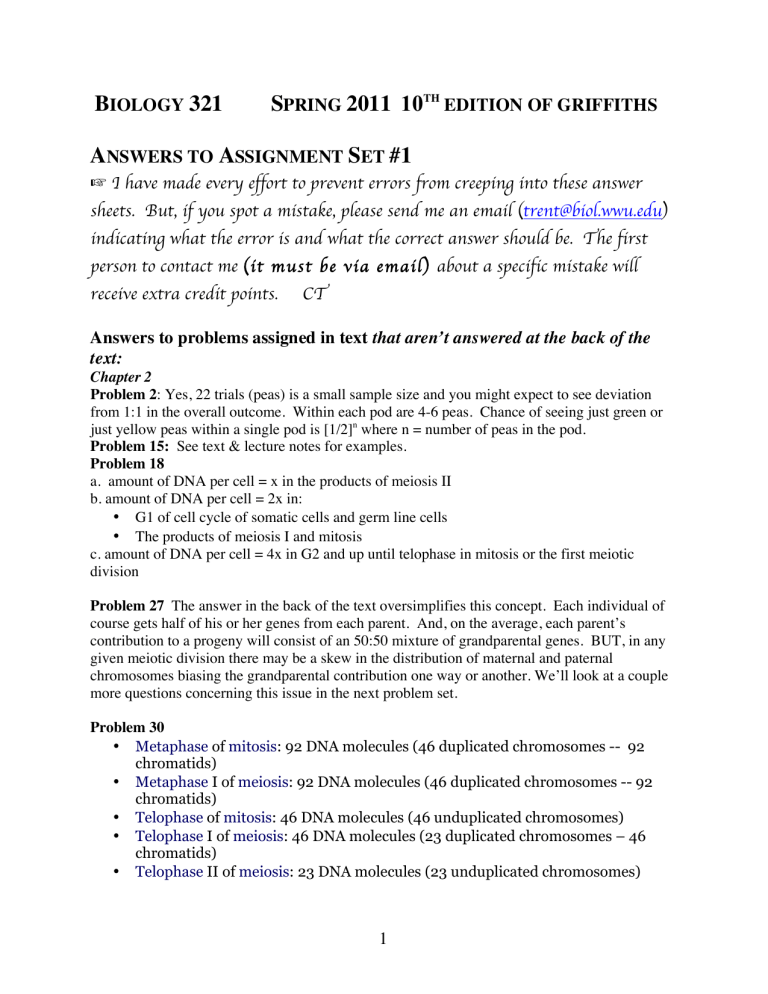
B
IOLOGY
321 S
PRING
2011
10
TH
EDITION OF GRIFFITHS
A
NSWERS TO
A
SSIGNMENT
S
ET
#1
☞ I have made every effort to prevent errors from creeping into these answer sheets. But, if you spot a mistake, please send me an email ( trent@biol.wwu.edu
) indicating what the error is and what the correct answer should be. The first person to contact me ( it must be via email ) about a specific mistake will receive extra credit points. CT
Answers to problems assigned in text that aren’t answered at the back of the text:
Chapter 2
Problem 2 : Yes, 22 trials (peas) is a small sample size and you might expect to see deviation from 1:1 in the overall outcome. Within each pod are 4-6 peas. Chance of seeing just green or just yellow peas within a single pod is [1/2] n where n = number of peas in the pod.
Problem 15: See text & lecture notes for examples.
Problem 18 a. amount of DNA per cell = x in the products of meiosis II b. amount of DNA per cell = 2x in:
• G1 of cell cycle of somatic cells and germ line cells
• The products of meiosis I and mitosis c. amount of DNA per cell = 4x in G2 and up until telophase in mitosis or the first meiotic division
Problem 27 The answer in the back of the text oversimplifies this concept. Each individual of course gets half of his or her genes from each parent. And, on the average, each parent’s contribution to a progeny will consist of an 50:50 mixture of grandparental genes. BUT, in any given meiotic division there may be a skew in the distribution of maternal and paternal chromosomes biasing the grandparental contribution one way or another. We’ll look at a couple more questions concerning this issue in the next problem set.
Problem 30
•
Metaphase of mitosis : 92 DNA molecules (46 duplicated chromosomes -- 92 chromatids)
•
Metaphase I of meiosis : 92 DNA molecules (46 duplicated chromosomes -- 92 chromatids)
•
Telophase of mitosis : 46 DNA molecules (46 unduplicated chromosomes)
•
Telophase I of meiosis : 46 DNA molecules (23 duplicated chromosomes – 46 chromatids)
•
Telophase II of meiosis : 23 DNA molecules (23 unduplicated chromosomes)
1
Problem 50
The results suggest that winged is dominant over wingless: selfing a winged plant can produce progeny with a 3:1 ratio of winged to wingless.
Some of the winged plants are homozygous and some heterozygous. The five unusual plants could be due to (a) error in classifying the phenotype (b) contamination (some of the progeny of one plant getting mixed in with the progeny from another plant) or (c) environmental or random effects on fruit development
An example of (c) would be dessication preventing genetically winged seed pods from developing as a winged fruit.
W= winged w= wingless
Winged (selfed) WW
Winged (selfed) Ww
Wingless (selfed) ww
Winged
×
wingless WW x ww
Winged
×
wingless Ww x ww
Winged
×
wingless WW x ww
Winged
×
winged WW x W- = WW x WW or WW x Ww
Winged
×
winged WW x W-
Problem 59
[1/2] 10 (use product rule)
Chapter 3
Problem 12: a. AaBb self – see basic Mendel for phenotype ratios b. AaBb self—try to work this out without a Punnet Square
Since genes are assorting independently consider each separately and then combine probabilities (product rule)
Aa self = ¼ AA ½ Aa ¼ aa likewise for Bb self
9 genotypic classes (3 possibilities for each gene)
Genotype frequencies: 1/16 AABB ¼ (4/16) AaBb 1/8 (2/16) AaBB
1/8 (2/16) AABb 1/8 (2/16) aaBb 1/16 aaBB 1/8 (2/16) Aabb
1/16 AAbb 1/16 aabb
Check to make sure that your frequencies add up to 1.
2
c. Recall that a test cross means that you cross the AaBb plant with an aabb plant. Test cross produces 4 phenotypic classes in equal numbers d. Likewise with genotype ratio
Problem 25: a. 9 genotypes b. 1/16 RRYY 2/16 RrYY 2/16 RRYy 4/16 RrYy 2/16 rrYy 1/16 rrYY 2/16
Rryy 1/16 RRyy 1/16 rryy c.
For genotypes: 3 n where n is the number of genes that are heterozygous. For each gene, there are 3 possible progeny genotypes. For phenotypes: 2 n where n is the number of genes that are heterozygous. Assuming complete dominance of one allele over the other, for each gene, there are 2 possible progeny phenotypes. d.
Either a self-cross or test-cross could be used. For each of the possible genotypes of a round, yellow pea, predict the results of a self-cross vs. a testcross.
Problem 48: Note that you are to assume that these genes assort independently.
This means that you can look at each gene independently of the others and use the product rule to find the probabilities asked for in each part of the question. a1 ½ X ¾ X ½ x ¾ X ½ = 9/128 a2 ½ X ¾ X ½ x ¾ X ½ = 9/128 a3
either
parent 1
or
parent 2: sum a1 & a2 = 18/128 = 9/64 a4 1-9/64 = 55/64 = any combo except parent 1 or parent 2 b1 [1/2] 5 = 1/32 b2 [1/2] 5 = 1/32 b3 like a3: 2/32 = 1/16 b4 like a4 : 15/16
Problem 57:
1) impossible – the alleles of the same genes are on non-homologous chromosomes
2) meiosis II
3) meiosis II
4) meiosis II
5) mitoisis
6) impossible --appears to be mitotic metaphase but alleles of sister chromatids are not identical
7) impossible – too many chromosomes
8) impossible – too many chromosomes
9) impossible – too many chromosomes
3
10) meiosis I
11) impossible – appears to be meiosis of genotype aaBB
12) impossible – the alleles of the same genes are on non-homologous chromosomes
Answers to Additional problems on Meiosis and Mendel
Ì Problem 1a 2n=48. The number preceding the n indicates the number of genome copies in a cell, which is the same as the number of copies of each chromosome. 2n indicates that the cell or organism is a diploid -- with 2 copies of each chromosome (2 genome copies). 48 (the number after the n ) indicates the total number of chromosomes in the diploid cell. n = 24 which tells us that a single copy of the genome is divided into 24 chromosomes (24 different double-stranded
DNA polymers). For humans, 2n=46.
Ì Problem 1b A single genome copy consists of 12 chromosomes or 12 different double-stranded DNA polymers (assuming the cell is in G1 or the beginning beginning of S phase.
Ì Problem 2 Mitosis or some sort of modified meiosis. A standard meiosis cannot take place in a haploid cell. Why not?
Ì Problem 3 a. 38/2 + 50/2 = 44 chromosomes in each somatic cell. b. Mitosis can proceed normally because pairing of chromosomes does not occur in this type of cell division. Note that although these two species have very similar genome content, the genome of the red fox is divided into 19 chromosomes and the genome of the Arctic for into 25. This structural difference causes problems in meiosis. The hybrid offspring are sterile because synapsis of homologs does not occur properly: in meiotic cells of these hybrid animals, both bivalents (paired chromosomes) and univalents (unpaired chromosomes) are present in prophase.
What does the occurrence of bivalents suggest about the genetic relationship between these two species? What is the problem with univalents?
4
Ì Problem 4 An odd number of homologous chromosomes causes all sorts of problems during prophase of the first meiotic division. Pairing may occur normally for two of the copies, which are then segregated properly. The third copy would go at random to one or the other daughter cells. Or all three copies may partially pair with each other. In either scenario, a gamete could, for example, get two copies of chromosome 1 and one copy of chromosome 2. Such chromosome imbalances are lethal. See following figure.
[ Viable gametes are produced rarely when a meiotic division produces a daughter cell with one copy of each chromosome and a daugher cell with two copies of each chromosome. These gametes are viable since the copy number is the same for all chromosomes. The larger n
(#chromsomes per genome copy) is, the less likely a viable gamete will be produced.]
Ì Problem 5 No. Using breeding procedures, there is no way to follow the inheritance of the trait if it exists in only one allelic form. [But if you’re studying the gene using molecular genetic tools, you would have no problem.]
5
Ì Problem 6 a. No, dominance cannot be determined. Either trait could be dominant and the parent (and progeny) with the dominant trait heterozygous. b . There are a couple possible strategies: One would be to first try to acquire information about the background of the mare and the stallion. Is either from a documented true-breeding line? To confirm any evidence along these lines, you must do additional crosses. If you can obtain animals from known truebreeding lines, your task will be relatively straight forward. If such animals are not available, you can try mating the the progeny with the parents. (Inbreeding is not a good idea for other reasons, but works in the context of this problem.) For example is the red foal is male, you could mate him with his mother to see if any black progeny are produced. If red is dominant, then both animals will be heterozygous and may produce a black progeny. If red is recessive, then both animals must be homozygous and will only produce red progeny.
If you do this cross and get two red progeny, can you conclude that red is a recessive trait? Why or why not?
Ì Problem 7 a. Note: Kayless and Worf’s sister have the Klingon phenotypes which must therefore be dominant since both individuals are heterozygous for these traits.
KS Ks kS ks
KS
Ks kS ks
KKSS
KKSs
KkSS
KkSs
KKSs
KKss
KkSs
Kkss
KkSS
KkSs kkSS kkSs
KkSs
Kkss kkSs kkss
Try to answer the questions without consulting the punnet square -- using the strategies discussed in class. a& b. curly klingon hair, large saggital crest 9/16
curly klingon hair, flat earthling forehead 3/16
silky earthling hair smooth, large saggital crest 3/16
silky earthling hair, flat earthling forehead 1/16 c . (1/2) 2 = ¼ Individual probability for each gene is ½ . d.
¼ There’s a couple different ways to do the calculation. One way is to figure out all the different genotypes that are homozygous recessive for both genes and then to add their individual probabilties together: kkss, 1/16; homozygous dominant for both: KKSS, 1/16; KKss, 1/16; and kkSS, 1/16).
Another way to think about it: for each gene there is a ½ probability of the offspring being homozygous for that gene. Overall probability is ½ X ½ e.
160 children: the larger the sample size the more likely it is that you will see the expected phenotypic ratio.
6
Ì Problem 8 Orange is dominant; yellow recessive. Spotted is dominant; plain is recessive. The plant collected from the wild was heterozygous for both traits.
Strategy for problems 9-11:
1) Read the problem carefully
2) Then figure out which phenotypes are dominant. To do this inspect the results for each cross. Some crosses will not be useful for determining dominance, but others will be revealing. For example, if the parents share the same phenotype for a particular trait, and the phenotype doesn’t breed true, then you know that it is the dominant phenotype.
3) As long as the traits in these questions are assorting independently, we can analyze the inheritance pattern of the traits one at a time.
4) Tease out the inheritance pattern of a given trait. If you see a 3:1 phenotypic ratio in the progeny then you know that both parents were het. If you see a 1:1 ratio then one parent was het and the other homozyous for the recessive allele.
Ì Problem 9 a.
straight wings and short bristles are dominant to curled wings and long bristles, respectively b.
Yes, standard Mendelian ratios showing independant assortment are observed.
(Only caveat would be that if the traits are very far apart on the same chromosome they will probably show independent assortment) c.
w+ = straight wings, w = curled wings b+ = long bristles, b = short bristles
Genotype of parents:
w + w b + b x w + w b + b
Cross #1........................................................
w + w b + b + x w + w b + b +
Cross #2.......................................................
ww b + b + x w + w b + b
Cross #3........................................................
w + w + b + b x w + w + b + b or w + w b + b
Cross #4.................. ......................................
ww b + b x w + w b + b
Cross #5........................................................
7
Ì Problem 10
Cross 1 p 1 p 3 l s l w X p 3 p 3 l s l w
Cross 2 p 1 p 3 l s l w X p 1 p 3 l w l w
Cross 3 p 1 p 3 l s l s X p 3 p 3 l w l w
Cross 4 p 1 p 3 l w l w X p 3 p 3 l s l w
Ì Problem 11 a.
green (cross #3) tall (crosses 1, 3 & 4) b.
MENDEL STYLE OF SYMBOLISM: G = green g = purple T = tall t
= dwarf ********* see also note below
Cross 1 GGTt X G-Tt
Cross 2 gg Tt X Gg t t
Cross 3 GgTt X GgTt
Cross 4 ggTt X Gg Tt
**** If you are told that green and tall are the wild-type phenotypes then you could use Drosophila style allele nomenclature (which we’ll cover in week 2): p+ = green allele p = purple d+ = tall allele d = dwarf
8
Ì Problem 12 The first thing to notice about this problem is that “wild” foxgloves are being examined. This means that you cannot assume that the crosses are conducted with true-breeding parental strains. In fact the data wouldn’t make sense if both parents were homozygous. single flower X double flower
↓
1/2 single and 1/2 double
From these data, you CANNOT determine dominance. A 1:1 ratio suggests that one parent is homozygous for the recessive allele and the other parent is heterozygous. But which is which?
One possibility:
S = single flower (dominant) s = double flower (recessive) parents are Ss (single ) X ss (double)
But the following scenerio also fits the data: d = single (recessive) D = double (dominant) parents are dd (single) X Dd (double)
The problem states that several different wild-type parents were crossed with the double parent and the results werea always the same. If the first scenario were true, then all wild flowers would have to be heterozygous. How likely is this?
Well, we really don’t know because we don’t know how common the mutant allele is this population of flowers.
OKAY, now you tell me how Mendel would have handled this experiment with the foxgloves
Ì Problem 13 Correct statesments: b, d & e
Ì Problem 14 Two correct answers: a & b. Both c and e are incorrect because they designate the dumpy as the wild-type allele. D is incorrect because the long& slender allele is not dominant. The laboratory stock (long and slender) is the wild-type strain. From the data presented you can infer that the dumpy phenotype is dominant. Note the symbolism used in answer a indicates which allele is dominant but provides no information as to which trait is considered wildtype. Conversely, the symbolism used in answer b indicates which trait is wild-type but provides no information about the dominance relationship of the two alleles.
9
Ì Problem 15 Which of the following statements are true for an organism where 3n = 12. Circle T or F for each statements. Answer false if any part of the statement is false.
F There are four copies of each chromosome in each somatic (non-sex) cell
T Before S phase, a single copy of the genome is contained in four doublestranded polymers of DNA.
T After S phase and before mitosis, there are 24 double-stranded polymers of
DNA in the somatic cell.
F Each somatic (non-sex) cell of this plant contains 12 chromosomes and the final products of meiosis contain 6 chromosomes. --SEE also ANSWER TO
PROBLEM 4
Ì Problem 16 – read the paper and figure out for yourself
Ì Problem 17 a. 1/4 AB 1/4 Ab 1/4 aB 1/4 ab b. See diagrams. Don’t forget to label a representative pair of homologs and sister chromatids and EACH and EVERY allele of the A and B genes. You Must show explicitly how all four genotypes are generated so you must show two different meiotic divisions
10
Problem 18
1. Assuming genes are assorting independently (3/4)(3/4) = 9/16
2. The fraction of F2 plants that show both dominant traits cannot be predicted without knowing the number of F2s that will be examined.
The answers to these questions are likely to be the same (or close to each other) when a very large number of F2 plants are examined. If the number of F2 plants examined is small, then you may not see the expected 9/16 ratio. For example, if you only look at 3 F2’s, then there is a [9/16] 3 = 17.8% chance that all three will show both dominant traits.
11

